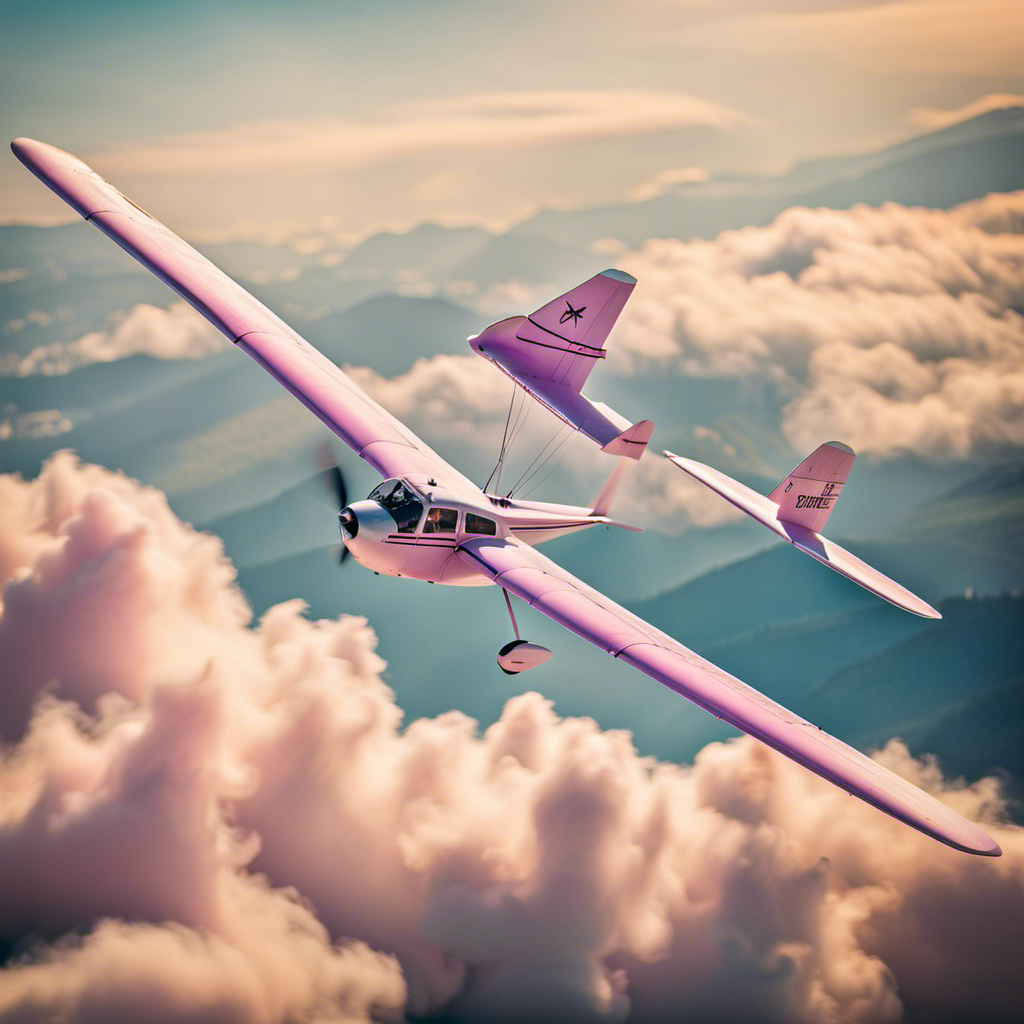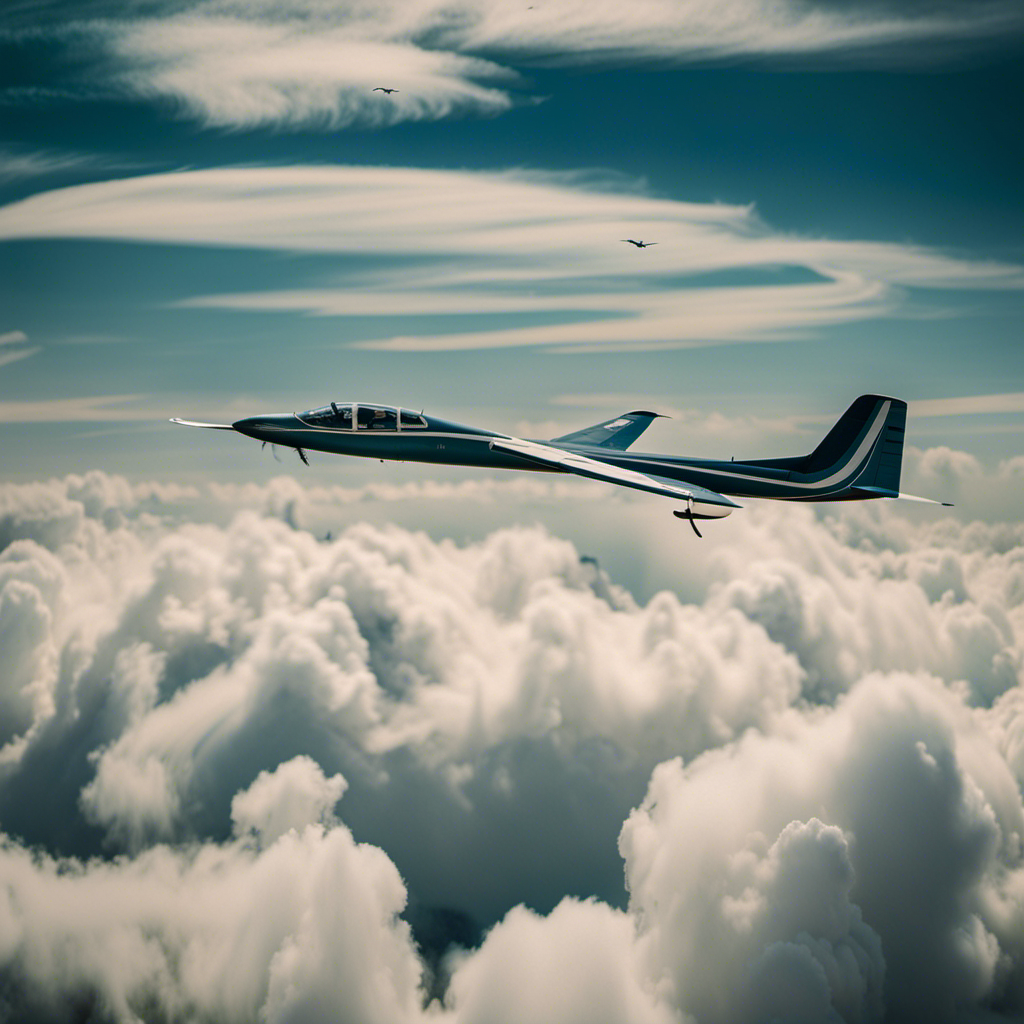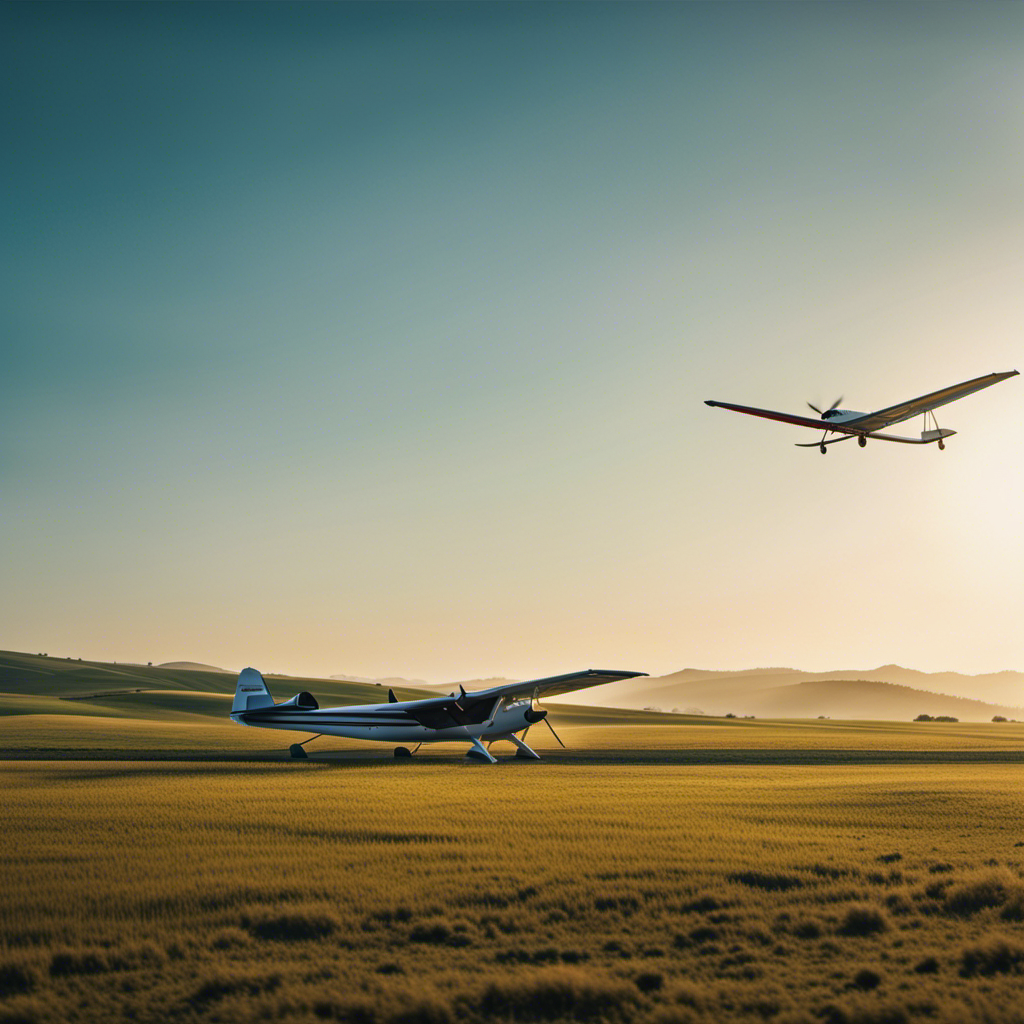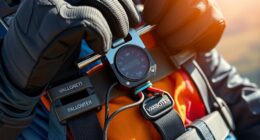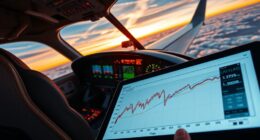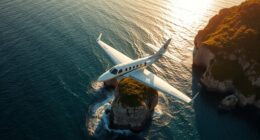As a pilot, I am always aware of the regulations regarding age and altitude that pertain to my profession.
Did you know that the minimum age to obtain a private pilot license in the United States is 17 years old? And for a commercial pilot license, the minimum age is 18?
These age limits are just the beginning of the complex regulations surrounding aviation. In this article, we will explore the intricate relationship between age, altitude, and the journey to becoming a pilot.
Key Takeaways
- Age requirements vary by country and license type
- Age restrictions ensure maturity and decision-making abilities for safe operation
- Altitude limitations ensure safety of passengers, cargo, and compliance with air traffic control
- Medical fitness requirements assess overall health and fitness for safe operation of aircraft
Minimum Age Requirements for Private Pilot License
The minimum age requirement for a private pilot license is 17 years old. In addition to meeting this age requirement, aspiring pilots must also fulfill certain medical fitness requirements. This includes passing a medical examination conducted by an authorized aviation medical examiner. The purpose of this examination is to ensure that the pilot is physically and mentally fit to safely operate an aircraft.
Furthermore, individuals seeking a private pilot license must complete the necessary training and experience requirements. These typically involve completing a minimum number of flight hours, both solo and with an instructor, as well as passing written and practical exams. By meeting these age, medical, and training requirements, aspiring pilots can obtain their private pilot license and begin their journey in aviation.
Moving forward, let’s explore the age requirements for obtaining a commercial pilot license.
Age Requirements for Commercial Pilot License
To obtain a commercial pilot license, there are specific age requirements that must be met. These age requirements vary depending on the country and the type of aircraft you want to fly. Here are the age and altitude requirements for helicopter pilots and international pilot licenses:
-
Helicopter pilots: The minimum age to obtain a commercial helicopter pilot license is usually 18 years old. However, there may be additional age limitations for certain types of helicopter operations, such as flying at higher altitudes or in specific weather conditions.
-
International pilot licenses: If you want to fly internationally, there may be age and altitude requirements set by the International Civil Aviation Organization (ICAO). These requirements ensure that pilots have the necessary experience and maturity to handle the challenges of flying in different countries and at higher altitudes.
Transition: Now that we’ve discussed the age requirements for commercial pilot licenses, let’s explore the altitude limits for different types of pilot licenses.
Altitude Limits for Different Types of Pilot Licenses
As a pilot with years of experience, I can confidently discuss the altitude restrictions for recreational pilots and the altitude limitations for commercial pilots.
For recreational pilots, there are certain altitude restrictions in place to ensure safety and minimize the risk of collisions with other aircraft. These restrictions typically limit recreational pilots to flying below a certain altitude, such as 14,500 feet.
On the other hand, commercial pilots have different altitude limitations depending on the type of aircraft they operate and the specific regulations set by aviation authorities. These limitations are in place to ensure the safety of passengers and cargo, as well as to comply with air traffic control requirements.
Altitude restrictions for recreational pilots
Before you can fly at higher altitudes as a recreational pilot, it’s important to understand the altitude restrictions. As a pilot, you need to meet certain medical qualifications to ensure your fitness for flying. This includes undergoing regular medical examinations and obtaining a medical certificate. Additionally, psychological evaluations are sometimes required to assess your mental well-being and ensure that you are capable of handling the stress and responsibilities of flying. These measures are in place to prioritize safety and ensure that pilots are physically and mentally fit to operate aircraft at higher altitudes. With these medical qualifications and evaluations in place, recreational pilots can enjoy the thrill of flying at higher altitudes while adhering to the necessary restrictions.
| Medical Qualifications | Psychological Evaluations |
|---|---|
| Regular medical exams | Assess mental well-being |
| Obtain medical certificate | Evaluate stress handling |
| Prioritize safety | Ensure mental fitness |
Transitioning to the subsequent section about altitude limitations for commercial pilots, it’s important to understand the differences in restrictions and qualifications between recreational and commercial flying.
Altitude limitations for commercial pilots
If you’re interested in flying commercially, it’s important to understand the altitude limitations set for commercial pilots. In terms of age, the Federal Aviation Administration (FAA) has outlined specific requirements. To become a commercial pilot, you must be at least 18 years old.
However, there are also altitude limitations that commercial pilots must adhere to. According to the FAA, commercial pilots are not allowed to fly above 41,000 feet in the United States. This altitude limitation ensures the safety and efficiency of commercial air travel.
It’s worth noting that age and altitude requirements differ for military aviation. In the military, pilots can start training at a younger age and may fly at higher altitudes depending on the specific aircraft and mission requirements.
Now, let’s move on to the next important aspect of becoming a pilot – the medical fitness requirements.
Medical Fitness Requirements
Aspiring pilots must meet certain health and fitness criteria in order to obtain their pilot’s license. These criteria are established to ensure that pilots are in good physical condition to safely operate an aircraft.
Medical examinations and certifications are conducted to assess an individual’s overall health, including their vision, hearing, cardiovascular health, and mental well-being, among other factors. These examinations are essential in determining a pilot’s medical fitness and ability to perform their duties effectively and safely.
Health and fitness criteria for aspiring pilots
The health and fitness criteria for pilots include meeting certain medical standards. Aspiring pilots must adhere to age restrictions and maintain a high level of physical fitness. Here are some key points to consider:
- Age Restrictions:
- Different countries have different minimum age requirements for obtaining a pilot’s license. In the United States, for example, you must be at least 16 to fly solo and 17 to obtain a private pilot license. Commercial pilot licenses have a minimum age requirement of 18.
- Age restrictions are in place to ensure that pilots have the maturity and decision-making abilities necessary to operate an aircraft safely.
Physical Fitness:
- Pilots must pass a medical examination to ensure they are physically capable of performing their duties. The medical assessment includes tests for vision, hearing, cardiovascular health, and other factors that could affect a pilot’s ability to fly safely.
- Physical fitness is crucial for pilots as they need to be able to handle the physical demands of operating an aircraft and be prepared for emergencies.
Aspiring pilots must meet these health and fitness criteria to pursue their passion for flying. Once these requirements are met, the next step is to undergo medical examinations and certifications to ensure they are fit to fly.
Medical examinations and certifications
Medical examinations and certifications are necessary to ensure pilots are physically fit to operate an aircraft safely. Pilots undergo comprehensive medical examinations to assess their overall health and fitness. These examinations evaluate various aspects such as vision, hearing, cardiovascular health, and mental well-being.
Additionally, pilots must obtain fitness certifications that demonstrate their ability to handle the physical demands of flying, including endurance, strength, and coordination. These certifications are essential to guarantee that pilots can perform their duties effectively and react appropriately in emergency situations. By ensuring pilots are in good health and physically capable, the risk of accidents or incidents caused by medical conditions is minimized. This rigorous screening process ensures that only those who meet the required medical standards can become certified pilots.
Transitioning into the subsequent section about ‘age and altitude factors in aviation safety,’ it is important to consider how these factors can further impact pilot performance and safety.
Age and Altitude Factors in Aviation Safety
Pilots need to be aware of the potential risks that age and altitude can pose to aviation safety.
When it comes to age, it is important for pilots to undergo regular medical examinations to ensure they are physically fit to fly. Certain medical conditions, such as heart disease or epilepsy, can increase the risk of experiencing a medical emergency while in the air.
Psychological factors also play a role in aviation safety. Pilots must have good mental health and be able to handle stress and make quick decisions in high-pressure situations.
Additionally, altitude can have physiological effects on the body, such as decreased oxygen levels, which can impact cognitive function and decision-making abilities. It is crucial for pilots to understand and manage these factors to ensure the safety of themselves and their passengers.
Transitioning into the next section, training and experience requirements further equip pilots with the necessary skills and knowledge to overcome these challenges.
Training and Experience Requirements
After discussing the importance of age and altitude factors in aviation safety, let’s now delve into the training and experience requirements for aspiring pilots.
Becoming a pilot requires not only a passion for flying, but also a dedication to honing your skills and knowledge. Here are four key aspects of the training and experience requirements:
-
Flight School: Attending an accredited flight school is essential to gain the necessary knowledge and flight hours.
-
Medical Fitness: Pilots must undergo rigorous medical examinations to ensure they are physically and mentally fit for the demands of the profession.
-
Flight Simulator Training: Simulators provide a realistic environment to practice various scenarios and enhance pilot skills.
-
Career Opportunities: Once the required certifications and flight hours are obtained, a wide range of career opportunities awaits, including commercial airlines, military aviation, and private aviation.
Now, let’s explore the impact of age and altitude in military aviation.
Age and Altitude in Military Aviation
Attending flight school and gaining experience are crucial steps in the journey to becoming a skilled pilot in military aviation. When it comes to altitude and military training, there are certain age restrictions in place. These restrictions are in place to ensure the safety and well-being of both the pilot and those on the ground. In military aviation, the minimum age to begin flight training is typically 18 years old. This allows for a certain level of maturity and responsibility to be developed before taking on the challenges of flying at high altitudes. Additionally, there may be certain age limitations for specific types of aircraft or missions. For example, pilots may need to reach a certain age before being eligible for high-altitude training or assignments. It is important to remember that these age restrictions are in place for a reason and are part of the comprehensive training process that prepares pilots for the demanding nature of military aviation.
| Age Restrictions in Military Aviation | |
|---|---|
| Minimum Age for Flight Training | 18 years old |
| Age Limitations for Specific Aircraft or Missions | Varies |
| Eligibility for High-Altitude Training | Age-dependent |
| Importance of Age Restrictions | Safety and Preparedness |
Moving forward, let’s explore some exceptions and special cases related to age and altitude in military aviation.
Age and Altitude Exceptions and Special Cases
As a pilot, it’s important to understand that there are exceptions to age requirements for exceptional young aviators. In certain cases, individuals who demonstrate exceptional talent and skill may be granted permission to fly at a younger age than the standard requirements dictate.
It’s also crucial to be aware of the unique altitude considerations that come with specific aircraft or missions. Different aircraft have different limits when it comes to altitude. Certain missions may require pilots to fly at higher or lower altitudes than usual, necessitating careful planning and preparation.
Exceptions to age requirements for exceptional young pilots
If you’re an exceptional young pilot, there may be exceptions to the age requirements for becoming a pilot. While most aspiring pilots have to wait until they reach a certain age to begin their training, there are some cases where young pilots with exceptional skills and abilities can start their journey earlier.
These age exceptions are typically granted on a case-by-case basis, taking into consideration factors such as maturity, responsibility, and previous flight experience. The aviation authorities understand that there are some young individuals who possess a natural talent and passion for flying, and they are willing to make exceptions to accommodate these exceptional pilots.
It is important to note that these exceptions are rare and require a rigorous evaluation process to ensure the safety and competence of these young aviators.
Transitioning into the next section, altitude considerations play a crucial role in aviation, influencing the performance and capabilities of aircraft in different missions and scenarios.
Unique altitude considerations for specific aircraft or missions
When it comes to flying specific aircraft or carrying out certain missions, there are unique considerations to take into account regarding altitude. For high performance aircraft, altitude considerations are crucial. These aircraft are designed to operate at higher altitudes, where the thinner air allows them to reach their maximum potential.
However, altitude limitations also exist for certain missions, such as aerial photography. When capturing images from above, it is important to consider the altitude at which the photographs will be taken. Too high, and the images may lack detail; too low, and the safety of the aircraft and crew may be compromised.
Understanding the specific altitude requirements for different aircraft and missions is vital for pilots to ensure the success and safety of their operations. Transitioning into the next section about career progression and advancement opportunities, mastering these altitude considerations is just one aspect of becoming a skilled and experienced pilot.
Career Progression and Advancement Opportunities
There’s a lot of potential for career progression and advancement opportunities in the field of aviation. As a pilot, the sky is not the limit when it comes to reaching new heights in your career. Here are some key ways that you can advance in the aviation industry:
-
Specialize in a specific type of aircraft, such as commercial airliners or helicopters. This can open up new opportunities for higher paying positions and increased responsibility.
-
Pursue additional certifications and ratings, like becoming an instructor or examiner. These credentials can make you more marketable and increase your earning potential.
-
Network and build relationships within the industry. Attend aviation conferences, join professional organizations, and seek out mentorship opportunities. This can lead to valuable connections and insider knowledge about job openings and career paths.
With the current wave of pilot retirements, the aviation industry is facing a shortage of experienced pilots. This presents an excellent opportunity for career advancement and quick progression up the ranks.
However, the future of age and altitude requirements is a topic that needs to be addressed in order to ensure safety and efficiency in the industry.
The Future of Age and Altitude Requirements
As we look towards the future of aviation, potential changes and updates to age and altitude regulations are a topic of great interest. With advancements in technology and the evolving nature of the industry, it is crucial to reevaluate the requirements for pilots.
These changes could have a significant impact on the qualifications and training needed to become a pilot. It is important to take into consideration the increasing complexity of aircraft systems and the role of automation.
Potential changes and updates to age and altitude regulations
You might want to keep an eye out for potential changes and updates to the age and altitude regulations for becoming a pilot.
As the aviation industry continues to evolve, new emerging trends and challenges are prompting authorities to reevaluate the requirements.
One key area of focus is the age at which individuals can begin their pilot training. Currently, most countries require individuals to be at least 17 years old to obtain a private pilot license, and 18 years old for a commercial pilot license. However, there is ongoing discussion about potentially increasing the minimum age to ensure better maturity and judgment in the cockpit.
Additionally, altitude regulations are also being examined, especially in light of advancements in aircraft technology and the increasing demand for pilot skills. These potential changes reflect the industry’s commitment to ensuring safety and efficiency in aviation.
As we explore the impact of technological advancements on pilot requirements, it becomes clear that the age and altitude regulations are just one part of a broader evolution in the aviation industry.
Technological advancements and their impact on pilot requirements
With advancements in technology, it’s important to understand how pilot requirements are being influenced. As the aviation industry continues to evolve, new career opportunities and pilot training advancements are emerging.
Here are some key factors to consider:
- Enhanced flight simulators provide realistic training experiences, preparing pilots for diverse scenarios.
- Automation systems reduce human error and improve safety during flights.
- Unmanned aerial vehicles (UAVs) create opportunities for pilots to specialize in drone operations.
- Virtual reality and augmented reality technologies enhance training programs and allow pilots to practice in immersive environments.
These advancements not only improve pilot training but also open up new avenues for aspiring aviators. With the right skills and knowledge, pilots can seize the growing career opportunities in this dynamic industry. It’s crucial for aspiring pilots and current professionals to stay updated and adapt to the changing requirements brought about by technological advancements.
Frequently Asked Questions
What are the age requirements for obtaining a private pilot license in different countries?
Age requirements for obtaining a private pilot license vary internationally. In the United States, you must be at least 17 years old, while in Canada, the minimum age is 14. Other countries may have different age restrictions.
Are there any specific medical conditions that could prevent someone from obtaining a pilot license at a certain age?
There are certain medical conditions that can prevent someone from obtaining a pilot license, regardless of their age. These conditions can include vision problems, hearing loss, and certain heart or neurological conditions. Age requirements also vary by country.
How does age affect the ability to handle high altitudes and the potential risks involved?
Age affects the ability to handle high altitudes differently in various age groups. Older individuals may experience more difficulty due to decreased lung function and higher risk of altitude sickness.
Are there any exceptions or special cases where individuals can obtain a pilot license at a younger or older age than the standard requirements?
Exceptions and special cases do exist when it comes to obtaining a pilot license. These unique circumstances allow individuals to become pilots at younger or older ages than the standard requirements. It’s important to explore these options and understand the specific criteria involved. "Age is just a number."
How do age and altitude requirements differ in military aviation compared to civilian aviation?
In military aviation, age requirements for pilot training may be slightly more flexible compared to civilian aviation. However, both military and civilian pilots face similar age and altitude risks and must meet certain criteria to ensure safety.
Conclusion
In conclusion, age and altitude play crucial roles in determining when one can become a pilot. From the minimum age requirements for different pilot licenses to the altitude limits for each type of license, these factors are carefully considered to ensure aviation safety.
Additionally, medical fitness requirements are in place to ensure pilots are physically and mentally capable of handling the demands of flying. While exceptions and special cases exist, it is clear that age and altitude are important considerations in the aviation industry.
So, next time you see a pilot soaring through the sky, ask yourself, ‘What age and altitude did they overcome to reach such heights?’
‘What age and altitude did they overcome to reach such heights, and what challenges did they conquer along the way?’
With a heart that soars as high as the skies, Aria, affectionately known as “Skylark,” is the driving force behind Soaring Skyways. Her journey into the gliding world began as a young dreamer gazing up at the soaring birds, yearning to experience the weightlessness and freedom they embodied. With years of experience both in the cockpit and behind the scenes, Aria’s commitment to the gliding community is unwavering.



